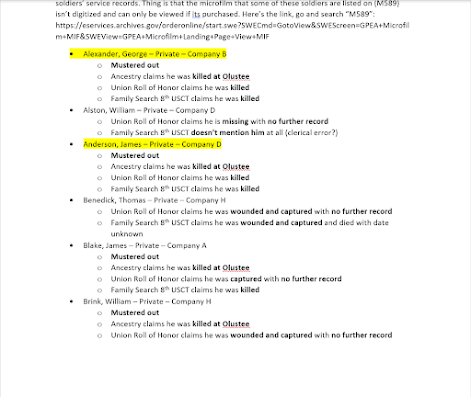Hello everyone, Aaron here checking for another week of the Olustee project internship. From what I’ve been through this week, both concerning the internship and concerning my other classes, I can tell that next week could potentially be my busiest week yet (an outcome I should have expected, honestly). Next week, I have an exam in my anthropology class, my first one this semester. I’m not particularly worried about that exam content-wise, but the simple mention of an exam naturally puts me a little on edge. Rather, I am a bit more nervous about what I will be doing for the internship. Granted, the progress the project has made in this last week is superb; I am not upset about that at all—it's more the fact that I think I’ll be outside my comfort zone next week.
This week, the other interns and I received an email from Dr. Gannon detailing how one of her associates took the information from the book detailing the Olustee order of battle (discussed in my last post) and compiled it into two separate Excel spreadsheets; Dr. Gannon simplified the data to make it easier to parse. The first spreadsheet includes all of the soldiers at Olustee who were listed as having died, been wounded, gone missing, or captured after the battle, with information on how they were injured and when and where they died (if available). This is a boon to our mission of gathering the names of those who are most likely buried in the Olustee mass grave. Even if the data doesn’t confirm if they died at Olustee, we can use the additional data to extrapolate if they might have. I’ll provide a small snippet of one of the data tables in said spreadsheet to illustrate my point.

These are the records of a few soldiers from the 40th Massachusetts Infantry Regiment that served at Olustee, along with their rank (second column), status (fourth column), and additional comments (fifth column). We’ll take Michael Walsh in the second row. The status column says “C”, meaning captured, and the comments column states he was brought to the Andersonville prisoner of war camp and died there several months later. So we can immediately rule him out. Daniel Bender in the seventh row was “W” for wounded, and given that the comments say he was wounded in the left arm, that means he made it to a field hospital to have said injury confirmed. Meanwhile, all the soldiers with highlighted columns, despite being either captured, killed, or missing, have no further records written about them. The ones who were captured or missing evidently didn’t make it to Andersonville. These are our likely candidates for burial in the mass grave, but we’ll need to investigate further.
The second spreadsheet details soldiers that were listed as having been “mustered out” in the Olustee order of battle book. This term refers to soldiers who were discharged; some of the regiments involved listed their soldiers as having been mustered out rather than explicitly killed, so these soldiers also need additional investigation. To conduct this investigation for both spreadsheets of soldiers, us interns and Dr. Gannon’s class can use Ancestry.com, a website that is home to the military records of some, but not all, of these regiments that served at Olustee. There we can get a look at scans of the documents these regiments wrote about their soldiers, and get our information on who died straight from the source. Dr. Gannon hinted that this investigation might start next week, which explains my belief that the coming days will be busy. We may end up connecting with her class personally and coordinating their efforts in combing through Ancestry and other sources. Getting into the archival research part of the project is exciting, but it does have me a little anxious. Regardless, it's a necessary part of the internship, and all we can do is our best. We’re finally getting a little closer to our goal.


Comments
Post a Comment